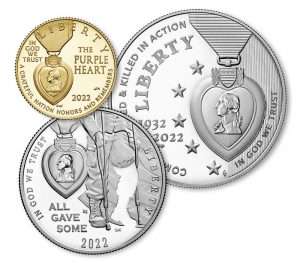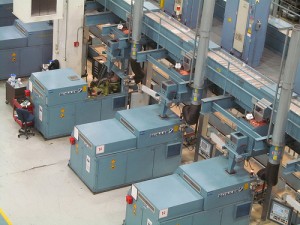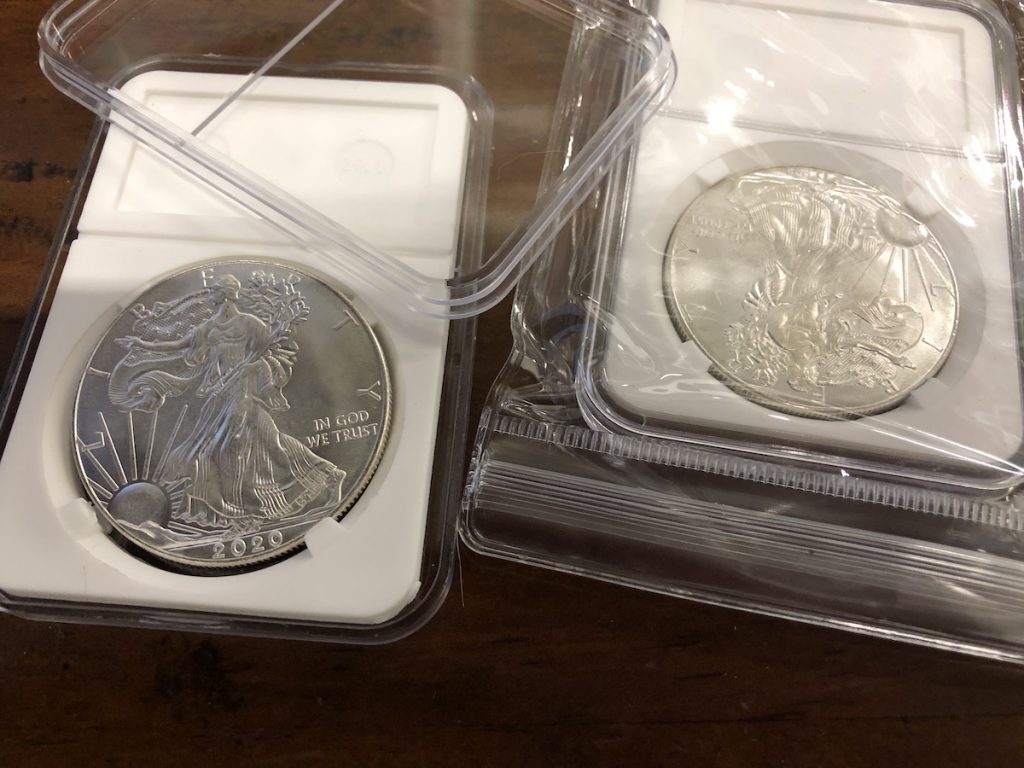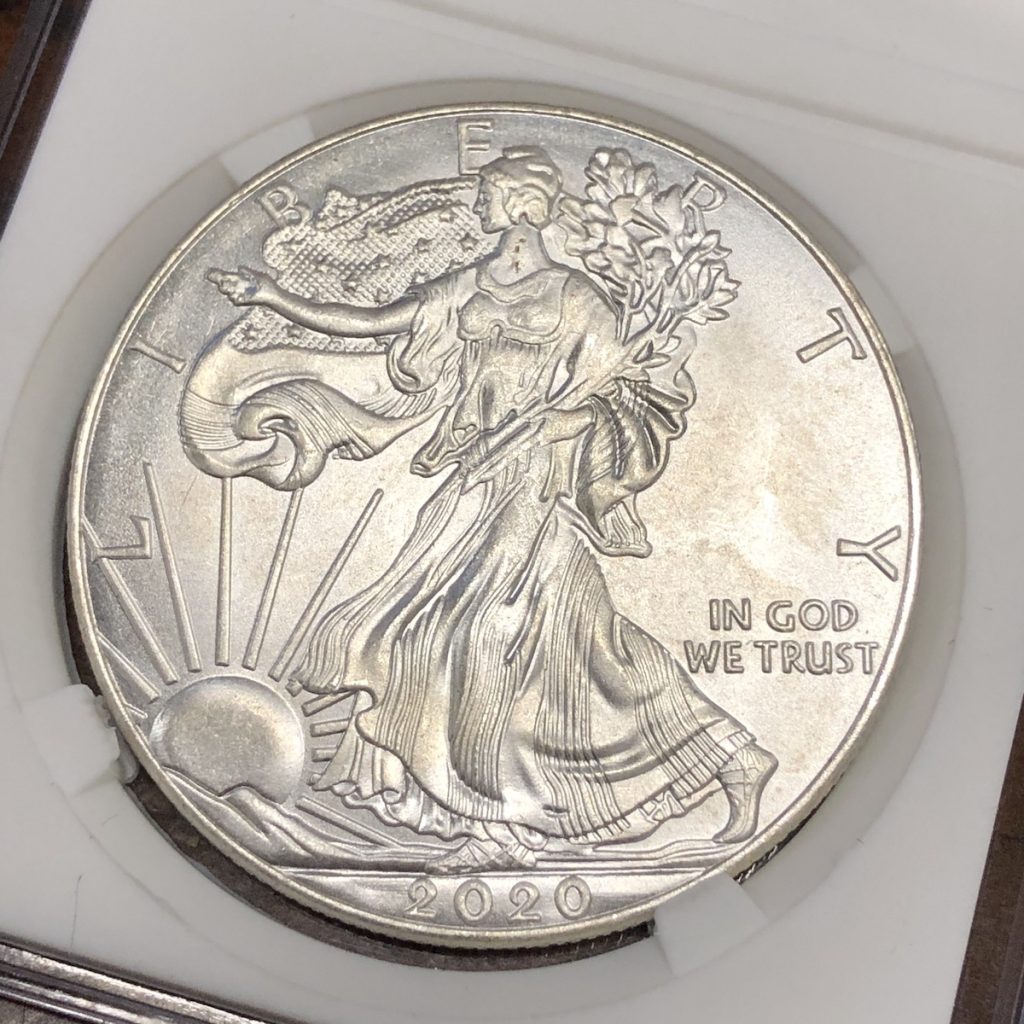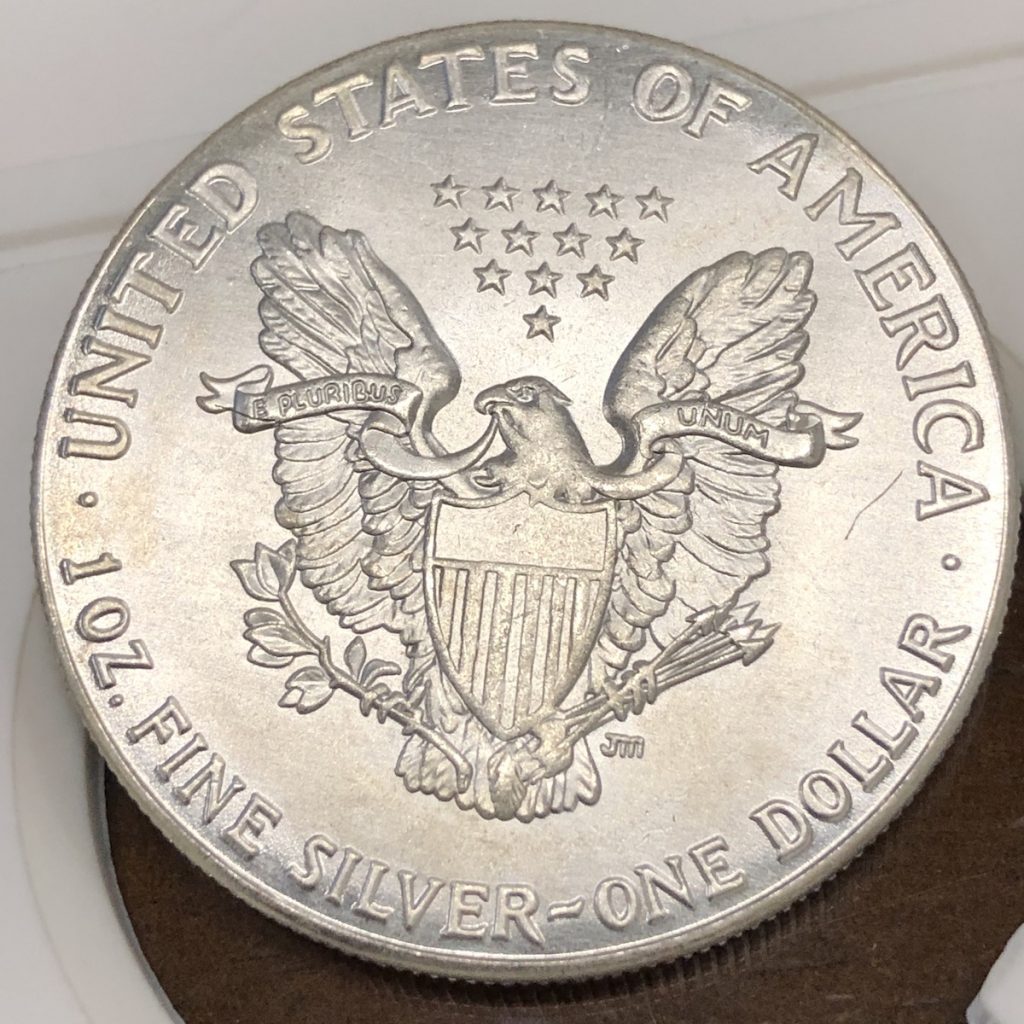Weekly World Numismatic News for May 29, 2022
Memorial Day took on national significance following World War I when the nation began to recognize all those who gave the ultimate sacrifice during all conflicts. By the end of World War II, most of the celebrations were renamed to Memorial Day. Memorial Day did not become an official holiday until 1967 with the passage of the Uniform Holidays Act (sometimes referred to as the Monday Holiday Bill). The law set Memorial Day to the last Monday in May, changing it from the traditional May 30.
The modern Memorial Day is a holiday celebrating the lives of those sacrificed in defense of the United States and its ideals at home and abroad. We honor the memories of those who paid the ultimate sacrifice so that we can collect what we like. They have gifted us the freedom so that I can write this blog and you can read and share it with others.
And now the news…
 → Read more at news.artnet.com
→ Read more at news.artnet.com
 → Read more at penarthtimes.co.uk
→ Read more at penarthtimes.co.uk
Acknowledging the U.S. Mint’s Accomplishments
During the recent media availability, U.S. Mint Director David Ryder said that the U.S. Mint is the only sovereign mint in the world to produce its bullion products since the start of the pandemic without interruption.
When COVID-19 affected the entire population, nobody understood the virus. In a panic, the entire world shut down. We did not understand the effects, but people were getting sick, requiring ventilators and scarce resources, and filling hospitals. For the U.S. Mint, there was an outbreak at the West Point Mint that affected production. They moved production to Philadelphia while those in West Point went into quarantine.
Like many critical businesses, the U.S. Mint reworked its schedule, added health precautions to keep workers safe, and continued production. While the numismatic world was worried about grading bullion coins from Philadelphia as an attempt to make a buck, the U.S. Mint was dealing with the health and safety of their workers.
It puts the industry’s selfishness in perspective.
Analysts give us many reasons why precious metals have risen, and the demand for bullion coins defies the usual analysis. Still, the U.S. Mint has been operating to supply a clamoring market.
Bullion production did slow down. The temporary closing of the West Point Mint reduced the resources they could use to produce bullion coins. There were also production problems by the U.S. Mint’s suppliers in producing the blanks they use. Those businesses were also facing COVID-19 issues that limited their capacity. And do not forget about the mines that could not operate or operated with limited capacity so they can protect their workers.
Ryder said that the procurement staff was diligent in using their resources to ensure the U.S. Mint had the materials to manufacture bullion.
Further limiting the U.S. Mint’s ability to manufacture bullion was the requirement to satisfy the orders for circulating coinage from the Federal Reserve.
As retailers were opening with new precautions, they reported that it was not easy to change because there were not enough coins. Headlines of a “coin shortage” became a topic. When the Federal Reserve investigated the issue, they found there were enough coins in the economy. Because the economy was not moving, circulating coinage was not circulating.
The problem was that the supply chain was interrupted and not moving as expected.
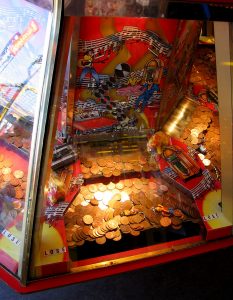
Coin Pusher in a penny arcade. Cambridge Midsummer Fair 2005 (Photograph © Andrew Dunn, cc-by-sa-2.0)
In the pandemic version of the game, the U.S. Mint manufactured coins so the Federal Reserve could dump billions into the economic hopper, hoping that some would fall out into the circulating economy.
In 2020, the U.S. Mint struck 14.774 BILLION coins, 23.7-percent more than they struck in 2019. Nearly every industry reported a reduction in demand and the ability to produce products. And the supply chain continues to affect production in some industries, including tech, where there is a shortage of computer chips. But the U.S. Mint was able to add over 14 BILLION coins to the economy.
The U.S. federal government continues to operate under mandatory pandemic-related protocols. As a federal bureau, the U.S. Mint continues to do its part to maintain social distancing and keeping its workers safe. No company, industry, or government has continued or boosted its production in this manner in the last 18 months.
Remember, the U.S. Mint does this without using any money from the general treasury. Their operating budget comes from the seignorage (profit) from the coin manufacturing process. When the profit exceeds their needs, a portion of the money is deposited in the general treasury. The more money the U.S. Mint makes, the more money they deposit in the general treasury. Talk about a money-making operation.
The U.S. Mint continues to have problems dealing with the collector market. Given the circumstances they have faced over the last 18 months, you have to admire their accomplishments.
Weekly World Numismatic News for August 29, 2021
A few weeks ago, I wrote that it was my impression “that the lawyers had more say over policy than the appointed director or the career executives.” It is not clear that the U.S. Mint has separated its policy decision from the advice of counsel.
Missing from the discussion is how the lawyers forced the U.S. Mint to violate the law. Even though they identified the Internet Robots (BOTs), the lawyers not allowing the U.S. Mint to resolve the problem puts the e-commerce system in violation of the Federal Information Security Management Act (FISMA). FISMA was passed in 2002 to require the government to protect computing resources.
Although it sounds like a technical issue, FISMA’s purpose is to allow bureaus like the U.S. Mint to protect public access to government resources. It also allows the government to do what is necessary to serve the public.
While the dealer community is part of the public, they are not the majority of the interested public. The U.S. Mint reported that only 18 authorized purchasers could access 10% of production at a 5% premium as part of its early access program.
The U.S. Mint deserves commendation for its ability to exceed production during the pandemic. Questions remain on the decisions on collector coin programs.
And now the news…
 → Read more at newswire.ca
→ Read more at newswire.ca
 → Read more at jpost.com
→ Read more at jpost.com
 → Read more at tcpalm.com
→ Read more at tcpalm.com
 → Read more at swfinstitute.org
→ Read more at swfinstitute.org
 → Read more at independent.ie
→ Read more at independent.ie
U.S. Mint Talks About Their Website and Ordering System
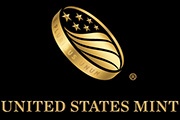 The U.S. Mint held a press availability for members of the numismatic media this morning. There will be more to say about the information presented, but the following are some highlights that will interest the numismatic community.
The U.S. Mint held a press availability for members of the numismatic media this morning. There will be more to say about the information presented, but the following are some highlights that will interest the numismatic community.
Mint management noted that the U.S. Mint is the only sovereign mint with continuing bullion production during the pandemic. In addition to the bullion coin production, the U.S. Mint has produced more circulating coins than any other time.
The U.S. Mint continues operating at the highest level while maintaining safety and controls to protect the employees during the COVID-19 pandemic.
Although it is easy to criticize the U.S. Mint, it is commendable that the bureau continued production but manufacturing more products than ever in the last 18 months.
U.S. MINT DIRECTOR DAVID RYDER noted that sales at the U.S. Mint had been declining prior to his arrival. Part of the reason is that there was not a permanent director in almost nine years. Ryder saw his job as trying to expand the product line to increase interest in the numismatic process.
U.S. MINT ASSOCIATE DIRECTOR OF SALES AND MARKETING MATTHEW HOLBEN said that the U.S. Mint had faced unprecedented demand for its products during the “black swan event.” According to Holben, the U.S. Mint sold more proof American Silver Eagle Proof coins in under a half-hour than they sold in 2019.
The U.S. Mint has 18 dealers that are registered authorized purchasers of numismatic products. These 18 dealers can purchase up to 10-percent of the numismatic products before the public sale. They credit the reduction in attempts to use automated methods to order (BOTs) now that the dealers can determine their inventory.
U.S. MINT DEPUTY CHIEF MARKETING OFFICER KIRK GILLIS said that since the first 2021 Morgan Dollar release, the catalog website could process 217 peak orders per second, up from 96 peak orders per second.
Gillis reported that “up to 60% of the activity on the sites were BOTs” based on the drop in traffic demand since the May 24 launch of the 2021 Morgan Dollar products. He said that the U.S. Mint had implemented technology to reduce the impact of scripts and BOTs used to order products.
The U.S. Mint will explore pre-ordering and waiting room software similar to the processes used by the ticket purchasing systems. They are also looking into other rate-limiting technology.
Beyond the highlights, there are other issues to explore. Stay tuned!
- The website can process “217 peak orders per second, up from 96 peak orders per second.” It was originally reported as “270 orders per second, up from 90.”
- Clarified the 60% reduction in BOT activity as being since the May 24 launch of the initial Morgan Dollar products.
Weekly World Numismatic News for August 22, 2021
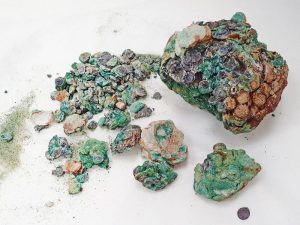
The ancient bundle of coins found on Habonim beach in Israel. (photo credit: OFIR HAYAT via The Jerusalem Post)
Although I post a link to every story I read on Twitter, the stories I find the most interesting make it to the weekly post. Regular readers will notice that I find many stories about people finding ancient coins make the weekly post.
I do not collect ancient coins, but I am interested in their stories. Even though the concept of a minor was not offered when I went to college, I filled many of my electives with history and political science classes. So when I see stories about these discoveries, I read each article thoroughly. Most are very well written and include a context around the era that the coins are from.
Recently, a professor who teaches ancient history using coins to highlight his lectures said that much of what we know about rulers was learned from studying coins. He is excited about new finds because the coins could add to their knowledge of history.
While discussing the coin hoard unearthed in Israel, we discussed collecting ancient coins. He said that once the collector decides what to collect, they can compile a nice collection for the same amount of money as assembling a nice Mercury Dime collection.
An important suggestion was to buy ancient coins from a reputable dealer. It will prevent you from a claim that you have stolen cultural property by a foreign government. This is because the U.S. State Department Cultural Property Advisory Committee (CPAC) accepts any claim from any country without understanding how they hurt legitimate collectors. I have written many posts on this subject. Just search for ACCG (Ancient Coin Collectors Guild) to read those posts.
Even if you do not collect ancient coins, read the articles about the finds from around the world. The articles are fascinating and provide a look at the world’s collective history.
And now the news…
 → Read more at christianheadlines.com
→ Read more at christianheadlines.com
 → Read more at smithsonianmag.com
→ Read more at smithsonianmag.com
 → Read more at thehill.com
→ Read more at thehill.com
 → Read more at robbreport.com
→ Read more at robbreport.com
 → Read more at dtnext.in
→ Read more at dtnext.in
SCAM ALERT: CHINESE COUNTERFEITERS ARE BACK
The Chinese scammers are back after a brief hiatus. They are flooding social media with advertising for fake coins. I found three ads from these scammers offering American Silver Eagles for $9.95 on Facebook in the last two days.
As I type this, silver is $23.73 per troy ounce. It means that that the American Silver Eagle contains $23.73 worth of silver. Even with a modest numismatic premium of 5-percent (below the current market value), a silver bullion coin should cost around $25.00. A quick market survey shows that legitimate dealers are selling ungraded American Silver Eagles for $33-36 each. Coins with the Type 2 reverse are selling for $1-3 more.
Proof American Silver Eagles are more expensive because they cost more to purchase. If the U.S. Mint sells American Silver Eagle proof coins for $73.00 and dealers on the authorized purchase program receive a 5-percent discount, the wholesale price is $69.35 per coin.
Who would sell a proof coin less than the wholesale cost? If it is a genuine coin, then it is likely stolen merchandise. Otherwise, scammers are selling fakes.
Before you purchase these alleged “good deals,” please remember my five rules:
- NO LEGITIMATE DEALER IS SELLING BULLION COINS FOR BELOW THE SPOT PRICE!
- IF THE DEAL IS TOO GOOD TO BE TRUE, IT LIKELY IS NOT A GOOD DEAL!
- IF THE DEALER DOES NOT IDENTIFY THEMSELVES ON THEIR WEBSITE, THEY ARE LIKELY HIDING SOMETHING.
Check the “About” or “Contact” page. If there is no contact information, then they are hiding. If the address is in China or the Middle East, they will sell you counterfeit merchandise. - IF THE SITE IS “POWERED BY SHOPLAZZA,” IT IS LIKELY A SCAMMER SITE.
According to contacts in the information security industry, the service is run by Chinese companies known to sell counterfeit merchandise. - IF THERE ARE ANY QUESTIONS, THEN DON’T PURCHASE THE COINS!
Last year, I purchased two coins knowing they are counterfeit for educational purposes only. I used gift cards to purchase the coins to prevent exposing my credit card information. Both coins are made of nickel-plated steel and contain no silver.
- Two counterfeit American Silver Eagles purchased from LIACOO, a company based in China who advertised on Facebook.
- The font for LIBERTY is too thin. Also, the stars in her flag draped over the shoulder are too small.
- Aside from the rims being to thin, look at the U in United and the dash between SILVER and ONE. These are not correct for the 2020 ASE.
